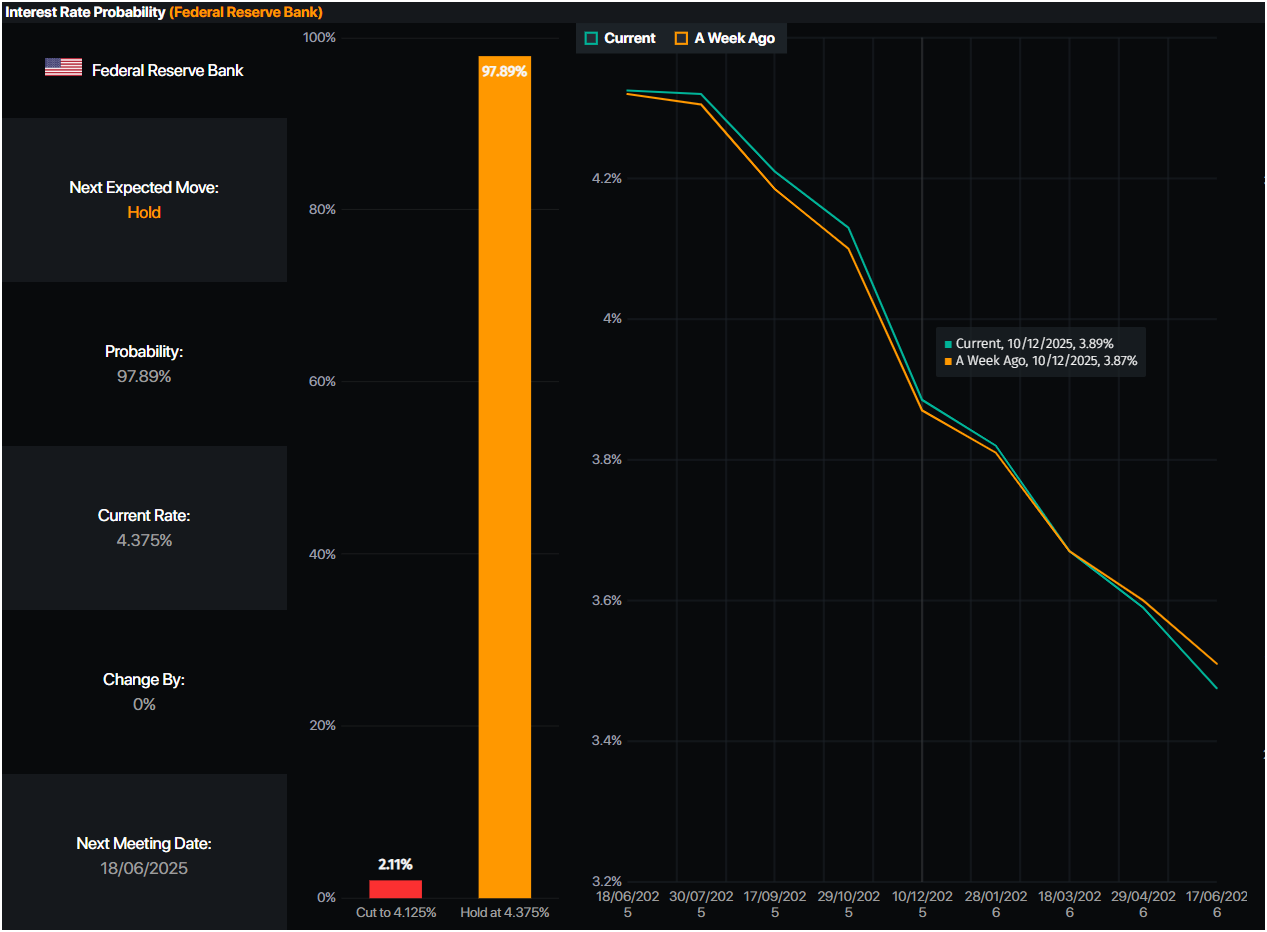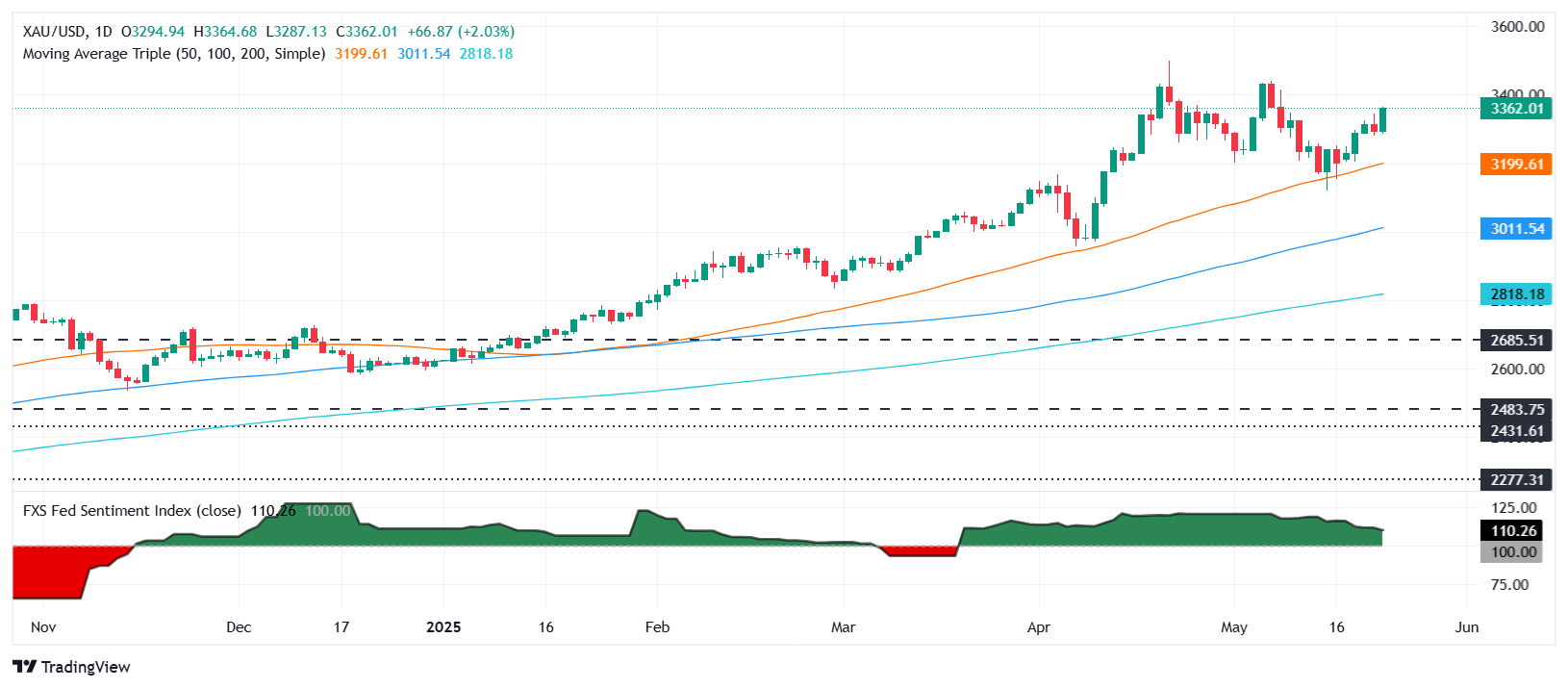Gold price soars nearly 2% as Trump targets EU with tariff threats
- XAU/USD rallies as Trump warns of 50% tariffs on EU imports, escalating trade war and boosting safe-haven demand.
- The US House passes a $4 trillion debt-heavy budget, with the Senate vote and inflation data in focus.
- Talks on Ukraine and Iran ease geopolitical stress, but markets remain risk-averse.
Gold's price uptrend resumed on Friday, with the yellow metal rising close to 2% daily and 5% in the week, as the US Dollar (USD) weakened further after US President Donald Trump escalated the ‘trade war’ with the European Union (EU). This and investors' woes regarding the US fiscal stance propel bullion prices higher, with XAU/USD trading at $3,359 after bouncing off a daily low of $3,287.
Before Wall Street opened, Trump said that discussions with the EU “are going nowhere” while threatening to impose 50% tariffs on the EU’s imports on June 1. US Treasury Secretary Scott Bessent also commented, “The president believes that the EU proposals have not been of the same quality that we’ve seen from our other important trading partners.”
Meanwhile, Bullion was boosted by the passage of Trump’s ‘One Big Beautiful Bill’ at the US House of Representatives, which would add close to $4 trillion to the US debt ceiling. The bill will next be passed to the Senate for its approval.
In the geopolitical front, the Russian Foreign Minister said the work on the memorandum leading to a ceasefire in Ukraine is advanced. Meanwhile,the US and Iran concluded on Friday a fifth round of negotiations in Rome over Tehran’s advancing nuclear program.
Data-wise, US housing data in May was mixed as Building Permits collapsed, but New Home Sales improved in April. In the meantime, a flurry of Fed speakers, led by St. Louis Fed Alberto Musalem and Chicago's Fed Austan Goolsbee, crossed the news wires.
Next week, the US economic docket will feature Durable Goods Orders, the release of the Fed’s last meeting minutes, the second estimate of GDP, and the Fed’s preferred inflation gauge, the Core Personal Consumption Expenditures (PCE) Price Index.
Gold daily market movers: Skyrockets amid risk-aversion spurred by Trump’s comments
- US Treasury bond yields halted their advance, with the 10-year Treasury note yield falling almost three basis points (bps) to 4.505%. Meanwhile, US real yields are also down 2.4 bps to 2.165%.
- Gold price outlook is optimistic, given the fragile market mood toward US assets sparked by the growing fiscal deficit in the United States, which ignited Moody’s downgrade of US government debt from AAA to AA1.
- The fiscal package approved by the US lower house is projected to raise the debt ceiling by $4 trillion.
- The US Dollar Index (DXY), which tracks the buck’s value against a basket of six currencies, sinks over 0.66%, down at 99.24, a tailwind for the Dollar-denominated precious metal.
- US Building Permits in April dipped from 1.481 million to 1.422 million for a loss of 4% MoM. Contrarily, New Home Sales for the same period increased by 10.9% MoM from 0.67 million to 0.743 million, revealed the US Census Bureau.
- St. Louis Fed Musalem said that companies are struggling to figure out how to manage uncertainty about supply chains, inventory and inflation. Meanwhile, Chicago's Fed Goolsbee said the Fed needs to wait for the dust to clear, the bar for action is higher until it happens.
- Money markets suggest that traders are pricing in 49.5 basis points of easing toward the end of the year, according to Prime Market Terminal data.

XAU/USD technical outlook: Jumps above $3,350 as uptrend resumes
Gold price extended its gains, poised to test the $3,400 figure in the near term. Bullish momentum remains strong, as depicted by the Relative Strength Index (RSI), which aims upwards with enough room before turning overbought.
That said, XAU/USD's first resistance is $3,400, the May 7 swing high at $3,438, followed by $3,450 and the all-time high (ATH) at $3,500.
On the bearish side, if Gold drops below $3,300, expect a move to the May 20 daily low of $3,204, ahead of the 50-day Simple Moving Average (SMA) at $3,199.

Gold FAQs
Gold has played a key role in human’s history as it has been widely used as a store of value and medium of exchange. Currently, apart from its shine and usage for jewelry, the precious metal is widely seen as a safe-haven asset, meaning that it is considered a good investment during turbulent times. Gold is also widely seen as a hedge against inflation and against depreciating currencies as it doesn’t rely on any specific issuer or government.
Central banks are the biggest Gold holders. In their aim to support their currencies in turbulent times, central banks tend to diversify their reserves and buy Gold to improve the perceived strength of the economy and the currency. High Gold reserves can be a source of trust for a country’s solvency. Central banks added 1,136 tonnes of Gold worth around $70 billion to their reserves in 2022, according to data from the World Gold Council. This is the highest yearly purchase since records began. Central banks from emerging economies such as China, India and Turkey are quickly increasing their Gold reserves.
Gold has an inverse correlation with the US Dollar and US Treasuries, which are both major reserve and safe-haven assets. When the Dollar depreciates, Gold tends to rise, enabling investors and central banks to diversify their assets in turbulent times. Gold is also inversely correlated with risk assets. A rally in the stock market tends to weaken Gold price, while sell-offs in riskier markets tend to favor the precious metal.
The price can move due to a wide range of factors. Geopolitical instability or fears of a deep recession can quickly make Gold price escalate due to its safe-haven status. As a yield-less asset, Gold tends to rise with lower interest rates, while higher cost of money usually weighs down on the yellow metal. Still, most moves depend on how the US Dollar (USD) behaves as the asset is priced in dollars (XAU/USD). A strong Dollar tends to keep the price of Gold controlled, whereas a weaker Dollar is likely to push Gold prices up.

